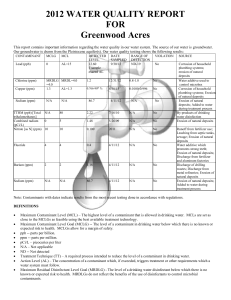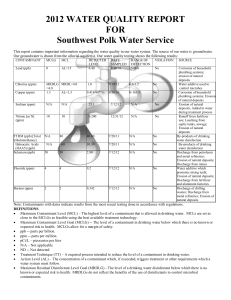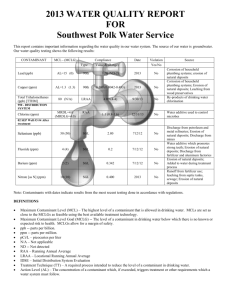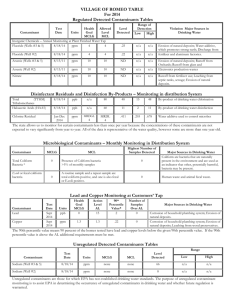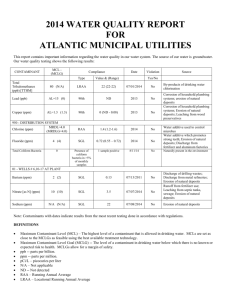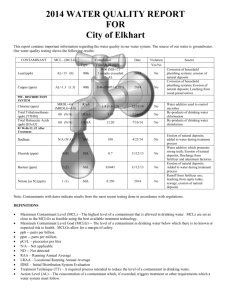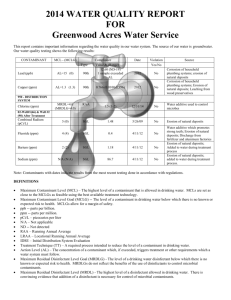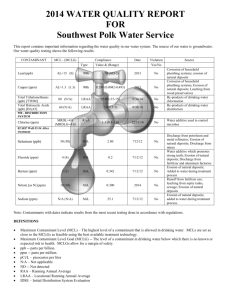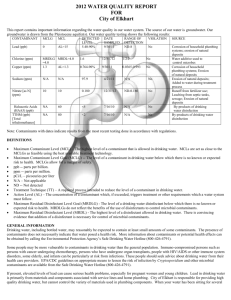contact information - thorpe water development company
advertisement
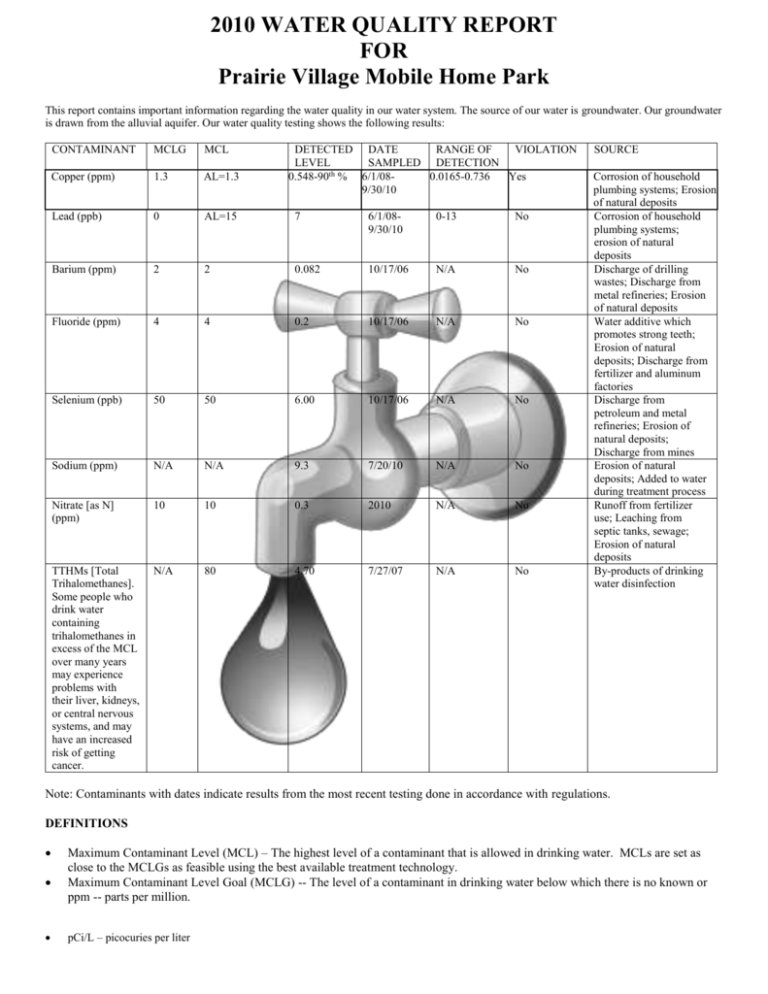
2010 WATER QUALITY REPORT FOR Prairie Village Mobile Home Park This report contains important information regarding the water quality in our water system. The source of our water is groundwater. Our groundwater is drawn from the alluvial aquifer. Our water quality testing shows the following results: CONTAMINANT MCLG MCL DETECTED DATE RANGE OF VIOLATION LEVEL SAMPLED DETECTION 0.548-90th % 6/1/080.0165-0.736 Yes 9/30/10 Copper (ppm) 1.3 AL=1.3 Lead (ppb) 0 AL=15 7 6/1/089/30/10 0-13 No Barium (ppm) 2 2 0.082 10/17/06 N/A No Fluoride (ppm) 4 4 0.2 10/17/06 N/A No Selenium (ppb) 50 50 6.00 10/17/06 N/A No Sodium (ppm) N/A N/A 9.3 7/20/10 N/A No Nitrate [as N] (ppm) 10 10 0.3 2010 N/A No TTHMs [Total Trihalomethanes]. Some people who drink water containing trihalomethanes in excess of the MCL over many years may experience problems with their liver, kidneys, or central nervous systems, and may have an increased risk of getting cancer. N/A 80 4.70 7/27/07 N/A No SOURCE Corrosion of household plumbing systems; Erosion of natural deposits Corrosion of household plumbing systems; erosion of natural deposits Discharge of drilling wastes; Discharge from metal refineries; Erosion of natural deposits Water additive which promotes strong teeth; Erosion of natural deposits; Discharge from fertilizer and aluminum factories Discharge from petroleum and metal refineries; Erosion of natural deposits; Discharge from mines Erosion of natural deposits; Added to water during treatment process Runoff from fertilizer use; Leaching from septic tanks, sewage; Erosion of natural deposits By-products of drinking water disinfection Note: Contaminants with dates indicate results from the most recent testing done in accordance with regulations. DEFINITIONS Maximum Contaminant Level (MCL) – The highest level of a contaminant that is allowed in drinking water. MCLs are set as close to the MCLGs as feasible using the best available treatment technology. Maximum Contaminant Level Goal (MCLG) -- The level of a contaminant in drinking water below which there is no known or ppm -- parts per million. pCi/L – picocuries per liter N/A – Not applicable ND -- Not detected Treatment Technique (TT) – A required process intended to reduce the level of a contaminant in drinking water. Action Level (AL) – The concentration of a contaminant which, if exceeded, triggers treatment or other requirements which a water system must follow. Maximum Residual Disinfectant Level Goal (MRDLG) - The level of a drinking water disinfectant below which there is no known or expected risk to health. MRDLGs do not reflect the benefits of the use of disinfectants to control microbial contaminants. Maximum Residual Disinfectant Level (MRDL) - The highest level of a disinfectant allowed in drinking water. There is convincing evidence that addition of a disinfectant is necessary for control of microbial contaminants. GENERAL INFORMATION Drinking water, including bottled water, may reasonably be expected to contain at least small amounts of some contaminants. The presence of contaminants does not necessarily indicate that water posed a health risk. More information about contaminants or potential health effects can be obtained by calling the Environmental Protection Agency’s Safe Drinking Water Hotline (800-426-4791). Some people may be more vulnerable to contaminants in drinking water than the general population. Immuno-compromised persons such as persons with cancer undergoing chemotherapy, persons who have undergone organ transplants, people with HIV/AIDS or other immune system disorders, some elderly, and infants can be particularly at risk from infections. These people should seek advice about drinking water from their health care providers. EPA/CDC guidelines on appropriate means to lessen the risk of infection by Cryptosporidium and other microbial contaminants are available from the Safe Drinking Water Hotline (800-426-4791). CONTAMINANT VIOLATIONS Copper. Copper is an essential nutrient but some people who drink water containing copper in excess of the action level over a relatively short amount of time could experience gastrointestinal distress. Some people who drink water containing copper in excess of the action level over many years could suffer liver or kidney damage. People with Wilson's Disease should consult their personal doctor. Continued sampling to try and determine the results. ADDITIONAL HEALTH INFORMATION Barium. Some people who drink water containing barium in excess of the MCL over many years could experience an increase in their blood pressure. Fluoride in children’s drinking water at levels of approximately 1 mg/L reduces the number of dental cavities. However, some children exposed to levels of fluoride greater than about 2.0 mg/L may develop dental fluorosis. Dental fluorosis, in its moderate and severe forms, is a brown staining and/or pitting of the permanent teeth. Because dental fluorosis occurs only when developing teeth (before they erupt from the gums) are exposed to elevated fluoride levels, households without children are not expected to be affected by this level of fluoride. Families with children under the age of nine are encouraged to seek other sources of drinking water for their children to avoid the possibility of staining and pitting. Your water supplier can lower the concentration of fluoride in your water so you will still receive the benefits of cavity prevention while the possibility of stained and pitted teeth is minimized. Removal of fluoride may increase your water costs. Treatment systems are also commercially available for home use. Information on such systems is available at the address given by your public water supply. Low fluoride bottled drinking water that would meet all standards is also commercially available. Nitrate in drinking water at levels above 10 ppm is a health risk for infants of less than six months of age. High nitrate levels in drinking water can cause blue baby syndrome. Nitrate levels may rise quickly for short periods of time because of rainfall or agricultural activity. If you are caring for an infant you should ask advice from your health care provider. OTHER VIOLATIONS The system had no other violations SOURCE WATER ASSESSMENT INFORMATION The Prairie Village Mobile Home Park water supply obtains its water from the alluvial aquifer. The alluvial aquifer was determined to be highly susceptible to contamination because the characteristics of the aquifer and overlying materials allow contaminants to move through the aquifer fairly quickly. The wells will be most susceptible to activities such as not be susceptible to most contaminant sources except through pathways to the aquifer such as abandoned or poorly maintained wells. A detailed evaluation of your source water was completed by the IDNR, and is available from Water Development at 515-289-2345. CONTACT INFORMATION For questions regarding this information, please contact Tom Thorpe at 515-289-2345 during the following hours: M-F 8:00a.m.-5:00 p.m..
